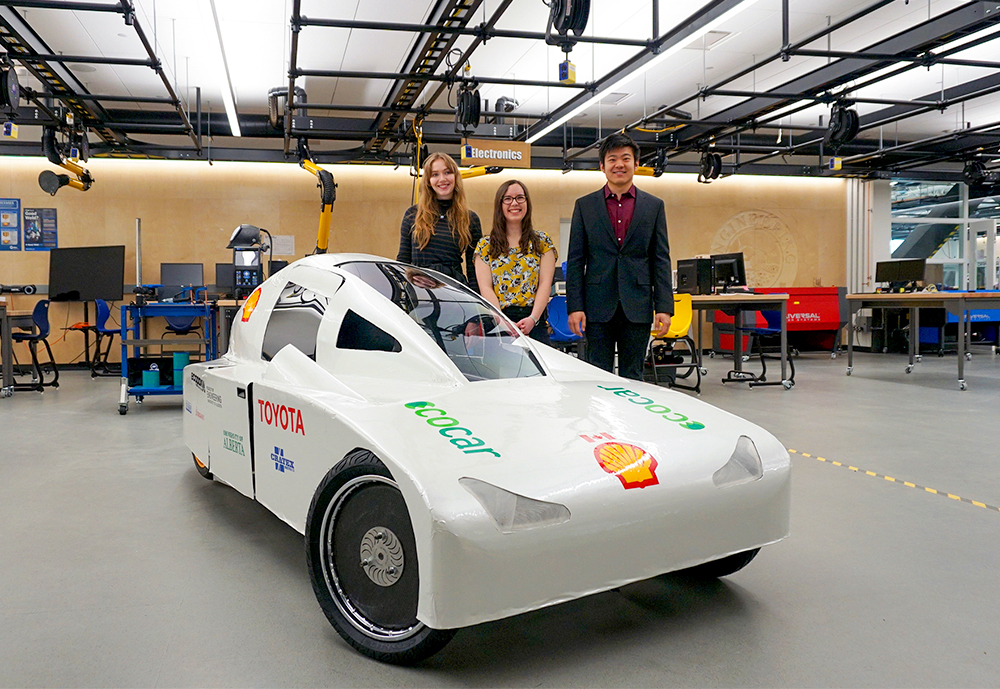Engineering clubs are created by students and for students. They provide a sandbox that lets future engineers make new things, sometimes starting with mistakes. COVID put the clubs in jeopardy, but they are coming back strong and punching above their weight.
Overhead
“It's not something that you expect a group of students to take on because of the technical complexity,” says Thomas Ganley, an engineering physics student and member of the club AlbertaSat.
The “something” he’s talking about is creating Alberta’s second ever satellite, Ex-Alta 2, and preparing it for launch in early 2023.
The group working on the Ex-Alta 2 comprises as many as 100 students at varying commitment levels. They are bringing the processes, training, leadership and network of a small professional engineering company to bear. And that’s sort of the point. “Tech and technology development, debugging, working through problems, designing or planning the various phases of a mission gives you skills that are really useful once you graduate and get out into industry,” says Ganley, who is the project manager.
Oh, and that satellite they built? It has real-world implications too. Ex-Alta 2 (part of a group of satellites) is scheduled to launch to the International Space Station in January 2023 from Cape Canaveral in Florida. From there, it will deploy into orbit, where it will monitor Earthly wildfires, wildfire risk zones and post-burn areas.
AlbertaSat isn’t the only sandbox for students to play in, where they can develop the skills to make a difference.
On the racetrack
Other student clubs, like EcoCar, take on equally massive projects. EcoCar designs, manufactures and then races a hydrogen fuel cell vehicle every year at the Shell Eco-marathon. Clubs give students spaces to fail (and try again), says mechanical engineering student and EcoCar project manager Rafid Khan.
“A lot of what we do in class is theoretical,” says Khan. “So with EcoCar, a huge focus is hands-on experience. If you want to design something, design it. And after you manufacture it, you’re probably going to find it didn’t meet your expectations. But you’re going to make mistakes, learn and get better.”
In the process, students also contribute to a lower carbon future. In April 2023, the EcoCar team will compete against hundreds of other student clubs in the Shell Eco-marathon, which brings together students from around the globe to design, build and drive energy-efficient vehicles. But it was touch and go for a minute.
Clubs, interrupted
From March 2020 until February 2021, like everything else, engineering clubs moved online. Pivoting to a design-only focus, they were forced to manage project delays while actively losing members and struggling to find new students to fill the gaps. Plus, the EcoCar competition moved to the virtual space — not quite as fun as racing a car you built with your bare hands.
“A big draw for us is being able to give students hands-on experience on certain types of machinery or welding or carbon fiber manufacturing,” says Khan. “It was tough to keep them around without that.”
With attention spans elsewhere, the groups’ funding suffered too. “EcoCar started to see its corporate sponsorship quiet down at the beginning of COVID,” says Khan.
AlbertaSat’s membership fell during the pandemic. “We have an obligation to the Canadian Space Agency to fulfill, and the work has to get done,” says Ganley. And those experiences affect students beyond university.
In the real world
“I think of my job as EcoCar, but in real life,” says Aishwarya Venkitachalam, ’20 BSc(MecEng), EcoCar alumna and current mechanical design engineer at Tesla. “I’m doing similar things at Tesla now, just at a much higher magnitude.”
Venkitachalam, who served in various roles in EcoCar from 2016 through 2020, vividly remembers the commute from her co-op work placement back to campus to work long nights at the club. But the experience allowed her to explore her creativity and made her confident when choosing a career in mechanical design. “My internships and my career couldn't have happened without EcoCar,” Venkitachalam says. “Clubs give you what companies are looking for — not a surface understanding of concepts, but a solid understanding that comes from practice. You will carry the experience throughout your career.”
---
Student project clubs, including EcoCar, AlbertaSat and others, give students opportunities to hone their skills and prepare them for their careers. Many of these clubs (see the ones listed below) are generously supported thanks to the Spirit of George Ford Endowment Fund, founded in memory of the U of A’s Dr. George Ford.

We at New Trail welcome your comments. Robust debate and criticism are encouraged, provided it is respectful. We reserve the right to reject comments, images or links that attack ethnicity, nationality, religion, gender or sexual orientation; that include offensive language, threats, spam; are fraudulent or defamatory; infringe on copyright or trademarks; and that just generally aren’t very nice. Discussion is monitored and violation of these guidelines will result in comments being disabled.